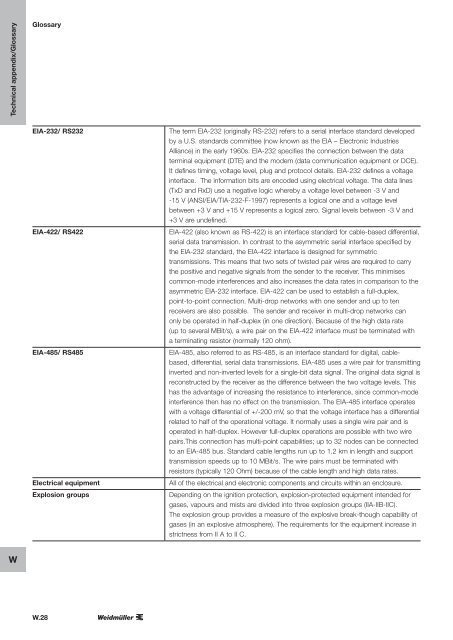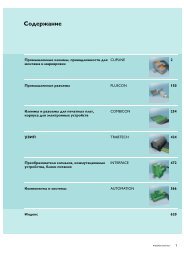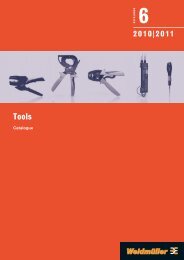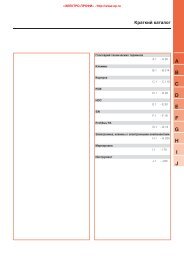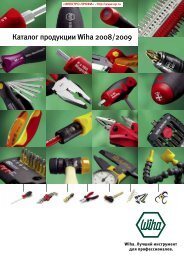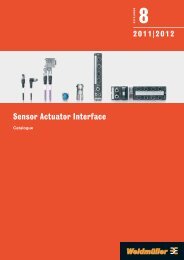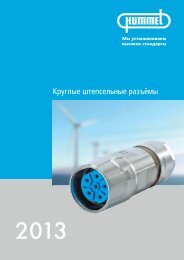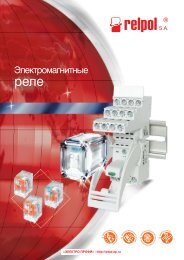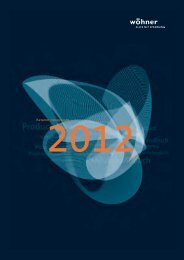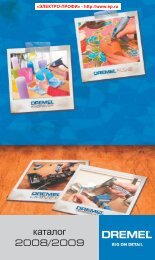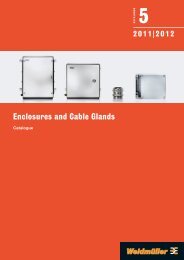ÐаÑалог Weidmuller: Electronics - Analogue Signal Conditioning
ÐаÑалог Weidmuller: Electronics - Analogue Signal Conditioning
ÐаÑалог Weidmuller: Electronics - Analogue Signal Conditioning
You also want an ePaper? Increase the reach of your titles
YUMPU automatically turns print PDFs into web optimized ePapers that Google loves.
Technical appendix/Glossary<br />
Glossary<br />
EIA-232/ RS232<br />
EIA-422/ RS422<br />
EIA-485/ RS485<br />
Electrical equipment<br />
Explosion groups<br />
The term EIA-232 (originally RS-232) refers to a serial interface standard developed<br />
by a U.S. standards committee (now known as the EIA – Electronic Industries<br />
Alliance) in the early 1960s. EIA-232 specifies the connection between the data<br />
terminal equipment (DTE) and the modem (data communication equipment or DCE).<br />
It defines timing, voltage level, plug and protocol details. EIA-232 defines a voltage<br />
interface. The information bits are encoded using electrical voltage. The data lines<br />
(TxD and RxD) use a negative logic whereby a voltage level between -3 V and<br />
-15 V (ANSI/EIA/TIA-232-F-1997) represents a logical one and a voltage level<br />
between +3 V and +15 V represents a logical zero. <strong>Signal</strong> levels between -3 V and<br />
+3 V are undefined.<br />
EIA-422 (also known as RS-422) is an interface standard for cable-based differential,<br />
serial data transmission. In contrast to the asymmetric serial interface specified by<br />
the EIA-232 standard, the EIA-422 interface is designed for symmetric<br />
transmissions. This means that two sets of twisted pair wires are required to carry<br />
the positive and negative signals from the sender to the receiver. This minimises<br />
common-mode interferences and also increases the data rates in comparison to the<br />
asymmetric EIA-232 interface. EIA-422 can be used to establish a full-duplex,<br />
point-to-point connection. Multi-drop networks with one sender and up to ten<br />
receivers are also possible. The sender and receiver in multi-drop networks can<br />
only be operated in half-duplex (in one direction). Because of the high data rate<br />
(up to several MBit/s), a wire pair on the EIA-422 interface must be terminated with<br />
a terminating resistor (normally 120 ohm).<br />
EIA-485, also referred to as RS-485, is an interface standard for digital, cablebased,<br />
differential, serial data transmissions. EIA-485 uses a wire pair for transmitting<br />
inverted and non-inverted levels for a single-bit data signal. The original data signal is<br />
reconstructed by the receiver as the difference between the two voltage levels. This<br />
has the advantage of increasing the resistance to interference, since common-mode<br />
interference then has no effect on the transmission. The EIA-485 interface operates<br />
with a voltage differential of +/-200 mV, so that the voltage interface has a differential<br />
related to half of the operational voltage. It normally uses a single wire pair and is<br />
operated in half-duplex. However full-duplex operations are possible with two wire<br />
pairs.This connection has multi-point capabilities; up to 32 nodes can be connected<br />
to an EIA-485 bus. Standard cable lengths run up to 1.2 km in length and support<br />
transmission speeds up to 10 MBit/s. The wire pairs must be terminated with<br />
resistors (typically 120 Ohm) because of the cable length and high data rates.<br />
All of the electrical and electronic components and circuits within an enclosure.<br />
Depending on the ignition protection, explosion-protected equipment intended for<br />
gases, vapours and mists are divided into three explosion groups (IIA-IIB-IIC).<br />
The explosion group provides a measure of the explosive break-though capability of<br />
gases (in an explosive atmosphere). The requirements for the equipment increase in<br />
strictness from II A to II C.<br />
W<br />
W.28


